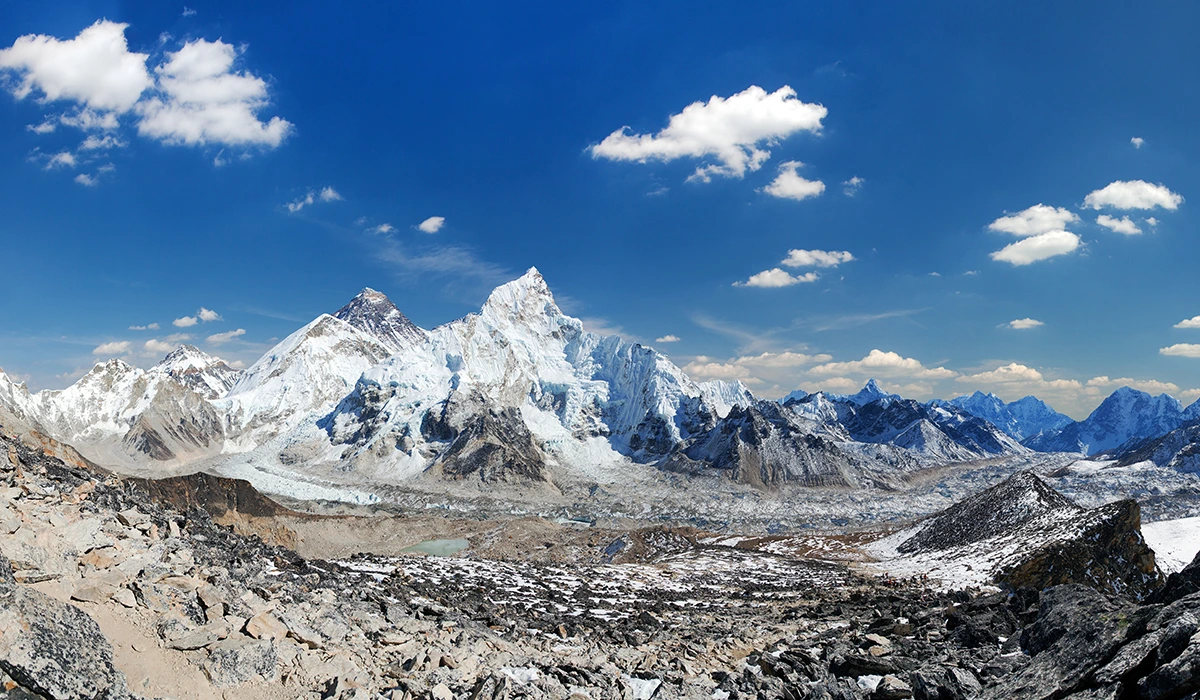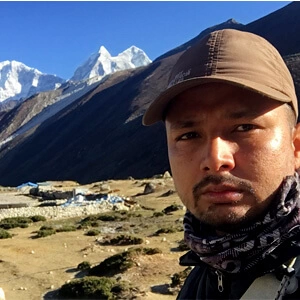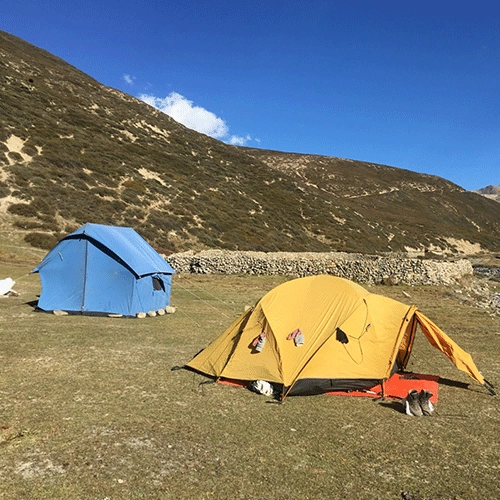Seasonal Overview of Everest Three Pass Trek
Spring (March to May)
Spring is considered one of the suitable times for the Everest Three Pass Trek. This pre-monsoon season is the most suitable for trekking because of the favorable trails, stable weather, clear visibility, and enhanced sunlight hours. As spring comes after the cold winter, you will be rewarded with stunning views of the surrounding mountain peaks that are still covered in snow.
You can witness the grandeur of nature at its freshest form with blooming flora, making the whole surrounding delightful. The forests are decorated by rhododendrons and a tapestry of wildflowers. You can feel a gradual rise in the temperature in this post-winter season. The moderate temperature of this season offers the most delightful trekking environment. The clear surroundings in this ideal season allow you to get unobstructed views of the snowy peaks.
The exceptional beauty of the surroundings and the sweet aroma of blooming flora captivate you, offering you a refreshing environment. During the Everest High Pass Trek, you will traverse across many high altitude places in the Khumbu Region. In addition, You will also cross the challenging Kongma La, Renjo La and Cho La high passes.
During springtime, the climatic conditions are stable, and the probability of facing harsh weather conditions is low. As there are fewer possibilities of heavy rain, snowfall and high winds, crossing the passes is relatively less challenging. The trail conditions are optimal and the clear skies offer excellent visibility, which helps you to navigate the high passes more conveniently.
Autumn (September to November)
Autumn season is considered one of the ideal times for trekking in Nepal. September, October, and November are considered autumn months in Nepal. September marks the beginning of the beautiful autumn season. There might be light rain in the initial week of September. However, by mid-September, the climate will be dry, with minimum to no chances of rainfall. The trails are suitable for trekking at this time. The landscapes are nourished by the rain from the preceding monsoon season, and you will be rewarded with a lush green environment.
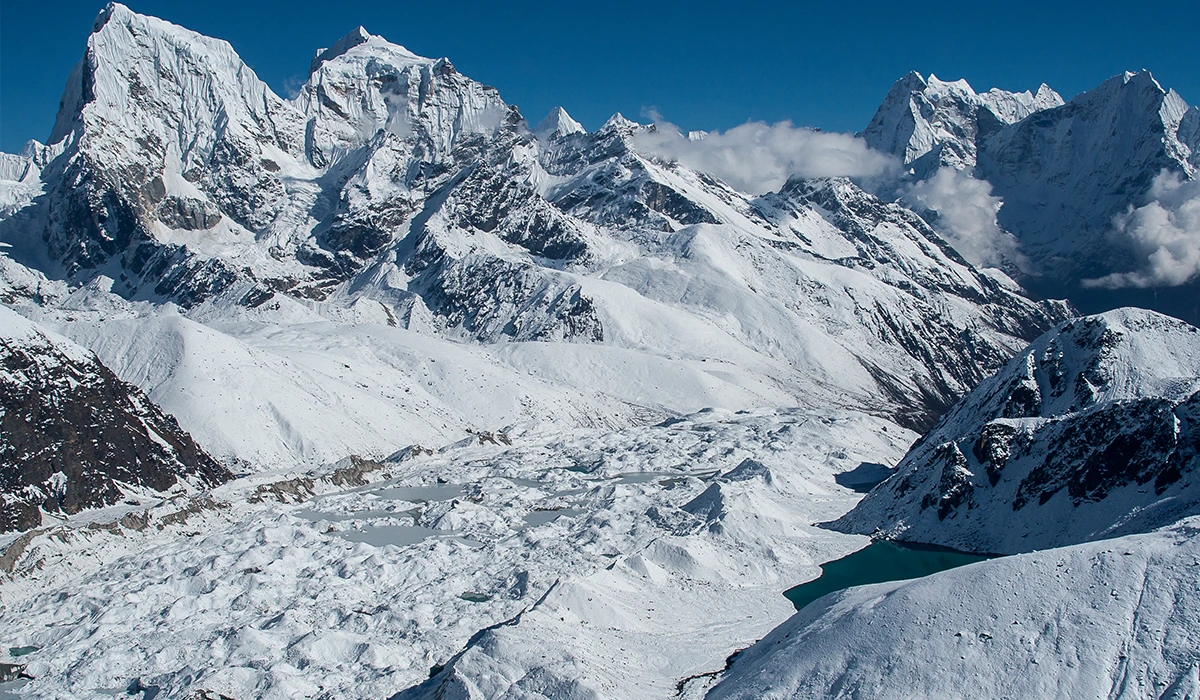
The days in autumn are warm and sunny. The trails are not muddy and slippery, allowing you to navigate the high passes smoothly. In addition, the skies are cloudless, and your trekking experience will be enhanced as you can get to witness the distinct view of snowy peaks. The mild temperature during this season makes your journey pleasant and comfortable. As the climatic conditions are stable, the steep high passes are relatively easy to navigate. The trails are not snowy or icy, which makes the treks safer by reducing the possibility of slips and injuries. In addition, the occurrence of any unexpected events is low, which means there are fewer chances of trip disruptions, allowing you to enjoy the maximum perks of the journey.
Summer/Monsoon (June to August)
The summer/ monsoon season is not peak time for High Passes Trek. The level of humidity is high during this season, which results in frequent downpours. The trails are wet, slippery, and muddy, making navigation challenging. In addition, it also increases the risk of slips and falls. The leeches can be found in the forested section of the trails, which can be unpleasant for the trekkers.
There is a chance of unexpected events like floods and landslides, which can cause trip interruptions. The visibility can get obstructed because of thick clouds and fog. Crossing the Everest High Pass is challenging by itself but when trails are slippery and muddy, it requires even more effort, which can cause exhaustion. However, there are also some good aspects of trekking in this season. As it is not high time for trekking the trails of Everest Region are less crowded, allowing you to trek feeling nature’s tranquility.
In addition, when the weather is clear you can witness the distinct views of surroundings. The sights of misty mountains in this season look ethereal, which is fascinating to witness. If you are planning to embark on the Everest High Pass trek in the summer/ monsoon season, then you must prepare adequately by being well informed about all challenges. You will need to stay updated, check the weather conditions and begin your trek only after taking the advice of the guides and ensuring that the trails are secure for traversing.
Winter (December to February)
Everest Region is the coldest during the winter season. During this time the region gets heavy snowfall especially at higher elevation points. The chilly weather conditions and snowy paths can make navigation challenging. There are some good parts of trekking in winter, such as less crowded and peaceful trails, magnificent snowy peaks and clear mountain views. In addition, the snowfall adds to the beauty of Everest Region. However, the freezing weather and blocked routes because of the heavy snowfall can add to the trek’s difficulty, especially when crossing the high passes.
The bitterly cold temperature can be difficult to handle for some trekkers. Similarly, snow can make trail slippery requiring a lot of physical effort. So, you should prepare for trek by packing warm clothes to keep yourself warm and safe.
The views of the snowy winter landscapes are enchanting. The skies are cloud free, which rewards you with crystal clear and stunning views of mountains, so if you prepare for the trek adequately with proper planning and caution, you can have an amazing traveling experience in this season.
Crowd Levels and Trail Conditions During Each Season
Trail Conditions
Navigation through the steep and snowy paths is easier when trail conditions are optimal. In the spring and autumn season, the climate is moderate and stable. With fewer chances of heavy downpours and snow, the passes are relatively easier to cross.
During the spring month of March, there can be some winter snow left, especially in the earlier days which requires caution. However, you will notice a gradual rise in the temperature as the month progresses. The trail conditions are suitable for trekking and you can safely navigate the challenging paths.
Similarly, during autumn months, the trails are clear and the temperature is suitable for trekking. As the visibility is excellent navigating the steep and rugged paths is fairly easy.
In the summer/monsoon season, trekking can be challenging as heavy downpours make the trail slippery. In addition, there may be poor visibility because of clouds and fog, which affect smooth navigation. Similarly, during winter the navigation may require extra effort as the trails in some sections of the Everest Region are covered with snow. While the views of the mountains are exceptional, traversing the snowy sections can be relatively challenging.
Crowd Levels
Crowd levels significantly influence the Trek. Each season offers distinct trekking experiences. When you embark on Trek in the high seasons (Autumn and Spring), you will have an interactive journey getting a chance to trek with fellow trekkers. Sharing your experiences and communicating with them will enhance your experience. You will get several opportunities for learning new things while interacting with the trekkers from around the world.
However, as the peak seasons attract many trekkers, the trails might be crowded. Securing good accommodation and flight tickets may be relatively difficult because of the large number of people opting for a trek at this time. So, booking of the trip early is recommended to get good accommodation.
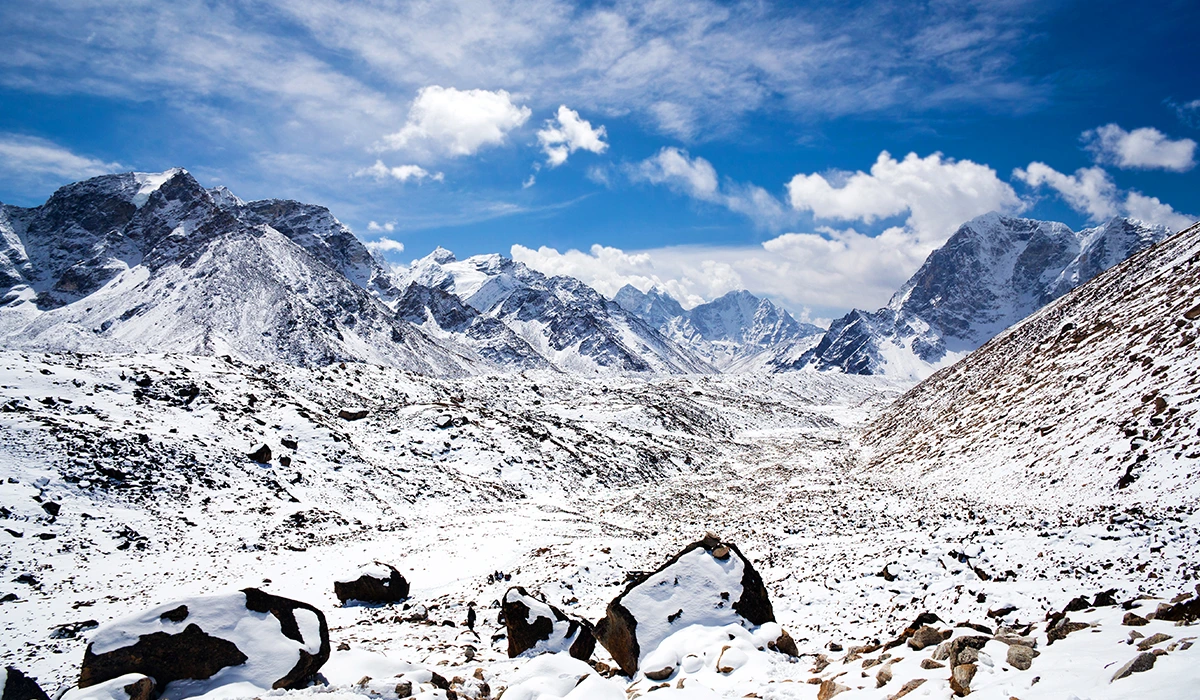
During the summer and winter seasons, there are few trekkers along the trail. The surroundings are tranquil. You can traverse across beautiful places while feeling nature’s serenity. The peaceful ambiance allows you to connect deeply with nature. However, it is still important to check the availability of accommodation even during the off-season to ensure a comfortable place to stay. You should be sure about if teahouses are operating and make informed decisions.
Gear Requirements for Each Season
Essentials Required for Every Season
As the weather in the higher zones fluctuates rapidly, it is highly recommended to pack rain gear for every season. Similarly, the higher zones are mostly cold, so you need to pack Down Jackets, Fleece Jackets, Warm Thermals, Gloves, Beanies, and Socks for all seasons. In addition, you should pack the essentials like a First Aid Box, Sunscreen, Lip Balm, Trekking Poles, Sun Glasses, Trekking Boots, Sleeping Bags, Flashlights, Sunhats and Headlamps.
Spring and Autumn
Spring and Autumn are ideal times for Everest Three Pass Trek with optimal temperatures and climatic conditions. The days are bright and sunny, and the temperature is moderate. However, during morning and nighttime, the higher altitude points are colder. So, you need to pack layered clothing to stay warm and secure. For spring and autumn, we recommend packing sweatproof shirts and bottoms, shorts and flexible hiking trousers, insulated gloves, trekking sandals and windproof jackets.
Summer/ Monsoon
In the summer/monsoon season there is frequent rainfall. So, packing all the essentials wisely. is necessary. We recommend packing rain jackets and pants, waterproof jackets, quick drying clothes, moisture wicking socks, lightweight shirts and sturdy hiking boots. In addition, make sure to include insect repellent in your backpack as you may come across leeches or bugs along the trail.
Winter
During the winter season, the temperature of the Everest Region drops significantly. So, it is essential to pack heavy clothes to keep yourself warm. You must include woolen socks, warm down jackets, Beanies, sweaters, thermal layers and a high quality sleeping bag. In addition, during winter, you can also pack ice axes and crampons to pass through the icy and snowy sections of the trail. When you pack appropriate layers of clothes, you can stay comfortable, cozy, and secure throughout the journey and complete it as smoothly as intended.
Altitude and Acclimatization Considerations by Season
Understanding acclimatization is crucial for Everest Three Passes Trek. During the trek you will be trekking to different altitude zones so you need to be accustomed to higher elevations to stay fit throughout the journey. You will gain significant altitude each day traversing across places like Lukla, Phadking, Namche Bazaar, Tengboche, Dingboche and many more. In addition, you will cross Kongma La, Renjo La and Cho La, which are the three high passes. All of the passes are situated over 5000 m. So adapting to the changing environment is essential to ensure a sucessful journey.
If you can’t get accustomed to high altitudes, then there is a possibility of getting altitude sickness. Altitude sickness is the most common concern during high altitude trekking. The most common symptoms of altitude sickness are Fatigue, Headache, Lack of appetite, Nausea or Vomiting, Dizziness, Shortness of breath and difficulty in sleeping.
Acclimatization
Spring and Autumn are peak times for trekking in the Everest Region. As the trails are dry and easier to navigate during these peak seasons, you will require relatively less effort compared to the off-season. However, following a proper trek schedule is necessary for acclimating. You should make sure that you have included the acclimatization days during the trek and adapt to the changing altitude. You should trek gradually, stay hydrated, and be well aware of your condition to ensure a smooth journey.
During the summer/ monsoon season, the frequent rainfall can make trails muddy and slippery, so navigation is comparatively tougher. In addition, when there is heavy rainfall the itinerary needs to be adjusted to ensure safety. So, make sure to be prepared for changes in the itinerary if necessary. Do not hesitate to include additional days if required to ensure proper acclimatization.
Incorporate rest days during the journey and drink plenty of water to maintain your hydration level, which will help with acclimatization. In addition, take care of your diet by including nutritional foods to stay healthy and energized.
Trekking in the winter season is also challenging compared to the peak trekking season, as some paths may be slippery because of heavy snowfall, which can increase navigation difficulties. However, incorporating rest days, trekking gradually and ensuring proper hydration will help you with acclimatization.
Trekking gradually is necessary during winter as challenging trail conditions require more strength. When you have to put in more effort the chances of exhaustion increase which may cause altitude sickness, so it is important to trek at gradual pace while also considering the weather. Make sure to be warmly dressed and effectively plan an acclimatization schedule for a smooth journey.
Recommended season for Everest Three Pass Trek
Every season offers unique and exhilarating experiences. Everest Three Pass Trek treats you with the most enchanting sceneries of the pristine Khumbu Region. When you choose the best time for Everest Three Pass Trek, you will enjoy the maximum benefits. Trekking in these seasons will uplift your traveling experience by rewarding you with distinct mountain views and the most stable climatic conditions.
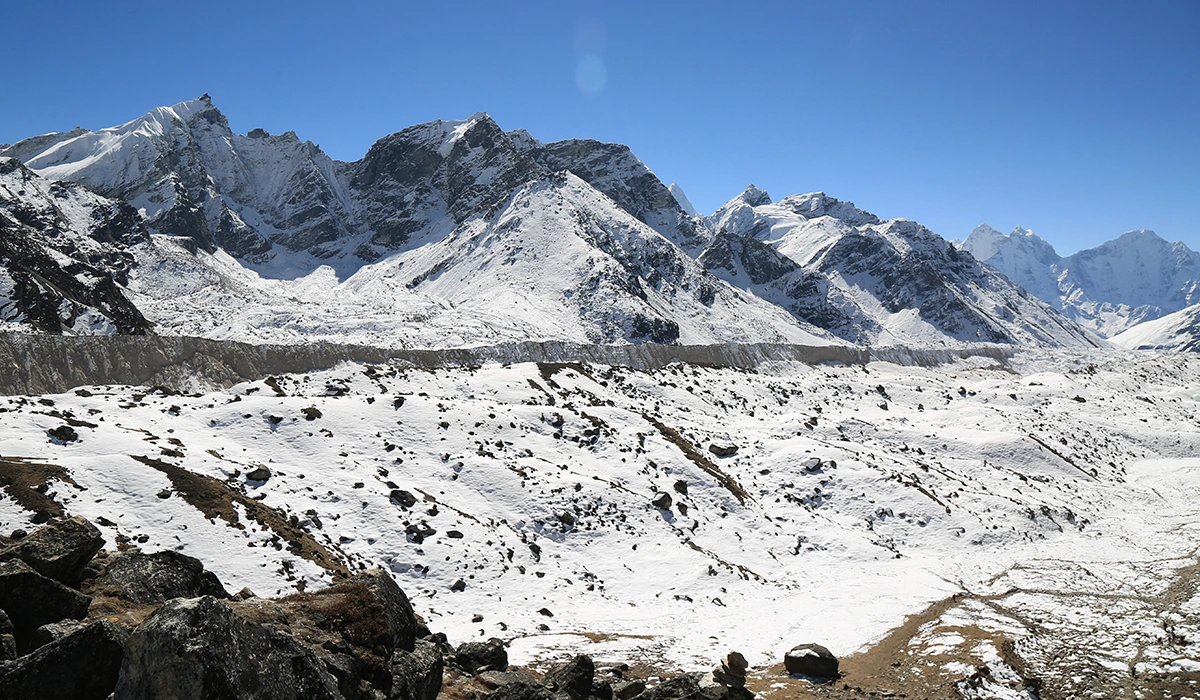
As trekking in the most favorable environment and witnessing the stunning scenery is the main goal of every trekker, selecting the ideal season (Autumn and Spring) is highly recommended for Everest Three Pass Trekking.
Tips for Everest Three Pass Trek During Different Seasons
Spring and Autumn
- Autumn and Spring are considered the ideal season for Everest High Pass Trek, so make sure to secure the accommodations by booking the trip in advance.
- The weather is generally stable in autumn and spring. However, weather fluctuations are common in higher zones, so it is highly recommended to pack warm clothes and rain gear.
- The scenery of verdant hills, mountain villages, deep valleys and snowy peaks is spectacular in autumn and spring. So, it is highly advisable to bring a camera to capture the magnificent snapshots of the ethereal Himalayan vistas.
Summer/Monsoon
- Pack Rain Gear to protect yourself from rain.
- You can carry insect repellent, as during the summer/monsoon season, the bugs and leeches may be present in the forested area.
- Include moisture wicking base layers of clothes and quick-drying clothes in your backpack.
- Check the weather forecasts regularly and head outside only after ensuring that the trails are safe and secure.
Winter
- Begin your trek early in the morning, as winter days are shorter.
- Ensure that you are properly hydrated.
- Everest Region is the coldest in the winter season. So, make sure to pack warm clothes.
- Book the trek with a licensed trekking agency, as they offer you a well guided journey.
- Be updated about the weather conditions and do not head out in unfavorable weather conditions.

